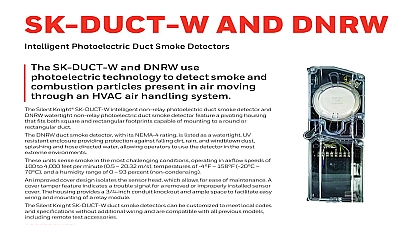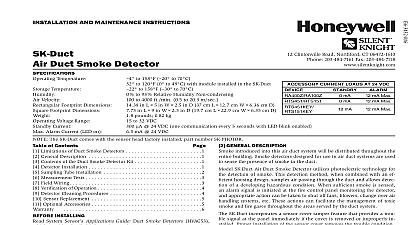Silent Knight SK-PHOTO-T-W Intelligent Photoelectric and Temperature Sensor Manual

File Preview
Click below to download for free
Click below to download for free
File Data
| Name | silent-knight-sk-photo-t-w-intelligent-photoelectric-and-temperature-sensor-manual-1054687932.pdf |
|---|---|
| Type | |
| Size | 869.80 KB |
| Downloads |
Text Preview
INSTALLATION AND MAINTENANCE INSTRUCTIONS Photoelectric and Temperature Sensor Voltage Range Current 24 VDC Alarm Current Current Humidity Range Temperature Range Velocity Load Rating refer to your isolator base module manual for isolator calculation instructions to 32 VDC uA one communication every 5 seconds with green LED blink on communication mA 24 VDC one communication every 5 seconds with red LED solid on mA 24 VDC one communication every 5 seconds with amber LED solid on to 93 Relative Humidity Non condensing to 115 0 to 47 to 4000 ft min 0 to 1219.2 m min 51 mm installed in B300 6 Base 156 mm installed in B300 6 Base 4.1 104 mm installed in B501 Base oz 95 g Clintonville Road Northford CT 06472 1610 203 484 7161 Fax 203 484 7118 268 listed for Open Air Protection 521 listed for Heat Detectors sensor must be installed in compliance with the control panel system manual The installation must meet the requirements of the Au Having Jurisdiction AHJ Sensors offer maximum performance when in compliance with the National Fire Protection Association NFPA NFPA 72 DESCRIPTION SK PHOTO T W is a plug in type multi sensor smoke sensor that com a photoelectronic sensing chamber and 135 57.2 fixed tempera heat detector across addressable analog communications The sensors an analog representation of smoke density over a communication to a control panel Rotary dial switches are provided for setting the sen address See Figure 1 The intelligent photoelectric and temperature also transmit an alarm signal due to heat at 135 57.2 per UL 1 ROTARY ADDRESS SWITCHES 0 0 LEDs on the sensor are controlled by the panel to indicate sensor status output is provided for connection to an optional remote LED annunciator RA100Z Knight panels offer different feature sets across different models As a certain features of the photoelectric and temperature sensors may be on some control panels but not on others These devices support protocol mode The possible features available if supported by the control are The sensor LEDs can operate in three ways off and blinking can be set to red green or amber This is controlled by the panel The remote output may be synchronized to the LED operation or con independent of the LEDs Devices are point addressable up to 159 addresses refer to the operation manual for the UL listed control panel for spe operation The photoelectric and temperature sensors require compatible communications to function properly Connect these sensors to control panels only Knight recommends spacing sensors in compliance with NFPA 72 In air flow applications with smooth ceilings space sensors 30 feet apart m When using the photoelectric and temperature sensors as a heat de in FM3210 compliant applications space sensors 20 feet apart 6 m specific information regarding sensor spacing placement and special ap refer to NFPA 72 or the System Smoke Detector Application Guide from Silent Knight GUIDE wiring must be installed in compliance with the National Electrical Code local codes and any special requirements of the Authority Having Proper wire gauges should be used The installation wires should color coded to limit wiring mistakes and ease system troubleshooting Im connections will prevent a system from responding properly in the of a fire power from the communication line before installing sensors Wire the sensor base supplied separately per the wiring diagram Figure 2 Set the desired address on the sensor address switches see Figure 1 Install the sensor into the sensor base Push the sensor into the base while it clockwise to secure it in place After all sensors have been installed apply power to the control panel and the communication line Test the sensor s as described in the TESTING section of this manual covers provide limited protection against airborne dust particles during Dust covers must be removed before the sensors can sense smoke sensors prior to heavy remodeling or construction 2 WIRING DIAGRAM Do not loop wire under 1 or 2 Break wire run to connections A OPTIONAL WIRING C0129 10 and temperature sensors include a tamper resistant capability prevents their removal from the base without the use of a tool Refer to base manual for details on making use of this capability testing notify the proper authorities that the system is undergoing and will temporarily be out of service Disable the system to unwanted alarms sensors must be tested after installation and periodically thereafter Test methods must satisfy the Authority Having Jurisdiction AHJ Sensors maximum performance when tested and maintained in compliance with 72 sensor can be tested in the following ways Functional Magnet Test P N M02 04 01 or M02 09 00 Hold the test magnet in the magnet test area as shown in Figure 3 This sensor can be functionally tested with a test magnet The test magnet simulates smoke in the sensing chamber testing the sensor and connections to the control panel The sensor should alarm the panel Two LEDs on the sensor are controlled by the panel to indicate sensor Coded signals transmitted from the panel can cause the LEDs to latch on or latch off Refer to the control panel technical documen for sensor LED status operation and expected delay to alarm Smoke Entry Sensitivity readings are available through the FACP Refer to the manufac published instructions for proper use Additionally canned aerosol simulated smoke canned smoke agent may used for smoke entry testing of the smoke detector Tested and ap aerosol smoke products are Fire Safety Climb 30S PURCHECK CENTURIAN SOLOA4 TRUTEST 2000 used properly the canned smoke agent will cause the smoke detector go into alarm Refer to the manufacturer published instructions for proper of the canned smoke agent aerosol simulated smoke canned smoke agent formulas will vary by Misuse or overuse of these products may have long term ad effects on the smoke detector Consult the canned smoke agent manufac published instructions for any further warnings or caution statements Direct Heat Method Hair dryer of 1000 1500 watts A hair dryer of 1000 1500 watts should be used to test the thermistors Di the heat toward either of the two thermistors holding the heat source 12 inches 30 cm from the detector in order to avoid dam the plastic housing The detector will reset only after it has had suf time to cool Make sure both thermistors are tested individually Multi Criteria Method A Testifire by SDi provides testing of the smoke and heat sensors Consult manufacturer published instructions for complete instructions sensor that fails any of these tests may need to be cleaned as described CLEANING and retested testing is complete restore the system to normal operation and notify proper authorities that the system is back in operation removing the detector notify the proper authorities that the smoke system is undergoing maintenance and will be temporarily out of Disable the zone or system undergoing maintenance to prevent un alarms Remove the sensor to be cleaned from the system Remove the sensor cover by pressing firmly on each of the four removal that hold the cover in place Vacuum the screen carefully without removing it If further cleaning is continue with Step 4 otherwise skip to Step 7 Remove the chamber cover screen assembly by pulling it straight out Use a vacuum cleaner or compressed air to remove dust and debris from sensing ch


